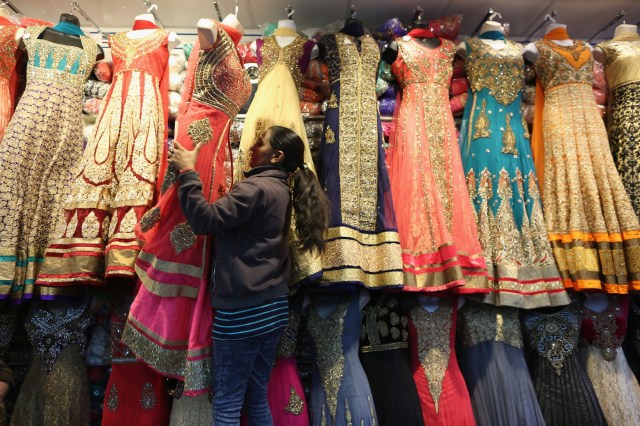A shop in Southall, Ealing Credit: Dan Kitwood / Getty

The UK vote to leave the European Union in June 2016 was a huge shock for metropolitan sophisticates. Unfortunately, the media has fallen short in its attempts to explain how it came about.
Vox pops of Leave voters are too often restricted to white working-class folk in northern England and provincial towns across the Midlands. Regular venues are pubs and working men’s clubs. Soundbites such as “make Britain great again” and “put the Great back in Great Britain” are typical. As well as featuring on primetime TV, these segments are often used as digestible clips on social media platforms such as Facebook and Twitter.
But the coverage simply doesn’t reflect the diversity of the Brexit vote. Not all Leave voters are white, left-behind people who live in de-industrialised ‘hollowed-out’ communities. Nor are they all dispossessed ‘nativists’ longing for a bygone era of British territorialism and imperial might. This idea of Brexit as a “white working-class revolt” – an uprising of the nostalgic in stagnant regions abandoned by the London-centric political establishment – is put about by the media, and there is some truth in it.
But there is much more to it, too. Why else, for example, would Milton Keynes, a new town commercial hub, and Watford, with its multi-ethnic population and Zone 7 London Underground station, vote Leave? Media portrayals barely begin to tell the story of why 17.4 million people voted to get out.
Data suggests that euroscepticism in Britain’s South Asian population – particularly the UK’s Indian ethnic group – is stronger than previously thought. Look at Osterley and Spring Grove. A relatively affluent, non-white-majority ward in the west London borough of Hounslow, it returned a Leave vote of 63.4%. Defying the wider national trend, non-white ethnicity was associated with voting Leave in the two multi-ethnic west London boroughs of Hounslow and Ealing.
A number of jurisdictions with large South Asian populations also delivered Leave votes, including Luton (56.5%), Hillingdon (56.4%), Slough (54.3%) and Bradford (54.2%). All have South Asian populations of 25% and above. It is fair to assume that these figures relied on healthy support for Brexit among voters of South Asian origin.
I wonder if political journalists and correspondents are aware of these voting patterns. If so, where are the vox pops with first-generation South Asian elders in Luton and Slough? How many economically secure west Londoners of Indian origin have been asked by mainstream media outlets to articulate their desire for the UK to leave the EU?
Why did the home-owning, higher-status workers in Osterley, many of whose origins are in Gujarat and the Punjab, not vote in a way – according to convention – that their socio-economic class would predict? [1. Why did some South Asians vote for a campaign that was, at times, seen as bigoted and xenophobic? I have discussed various reasons here: perhaps voters didn’t feel particularly European; or perhaps the Leave camp’s pro-Commonwealth rhetoric pulled hard on the heartstrings; or perhaps the supposedly xenophobic and racist elements of the Leave campaign just didn’t offend many well-integrated, South Asian voters who strongly identify with the UK.]
Their views could add great value to the national coverage as to how the Leave vote came about – which still seems to mystify many. London-based journalists don’t need to visit working-men’s clubs in the north and pubs in the provincial Midlands to find Brexit voters. They could look no further than the mandirs and gurdwaras in west London.
Osterley is a ten-minute drive from Sky News HQ, and comfortably under an hour from BBC Broadcasting House on the Tube. So why the myopia? Perhaps it is simply a case of the media being incredibly lax, not with their travel plans but with their research. Maybe the broad exclusion of South Asian Leavers is simply the result of ignorance.
The cynic in me wonders if this is the conceivably intentional no-platforming of non-white Brexit voters whose attitudes are at odds with the media’s dominant narrative. Could it be an orchestrated effort that seeks to portray the Leave result as precipitated by nostalgic, left-behind, lesser-educated, misinformed white working-class folk – low-resourced “simpletons” driven by their irrational jingoistic impulses? In short, is it a Remain plot?
I would like to think not, but either way, the use of vox pops in ‘Brexit Britain’ shows that the media cannot be fully trusted to delve into why important political and social events, such as the Leave vote in June 2016, take place. The appetite for thorough investigation and reporting realities has increasingly given way to the peddling of simplistic narratives.
In the case of Brexit, the dominant media narratives fail spectacularly in capturing the complex nature of British euro-scepticism. Brexit has exposed an unfortunate reality – that the media’s commitment to reporting the facts, pure and simple, leaves a lot to be desired. And while this could be the product of bad journalism and poor research, there is also the possibility that that its ‘research and inform’ function has been usurped by a role as ‘narrative manufacturers’. And that’s a big worry.










Join the discussion
Join like minded readers that support our journalism by becoming a paid subscriber
To join the discussion in the comments, become a paid subscriber.
Join like minded readers that support our journalism, read unlimited articles and enjoy other subscriber-only benefits.
Subscribe